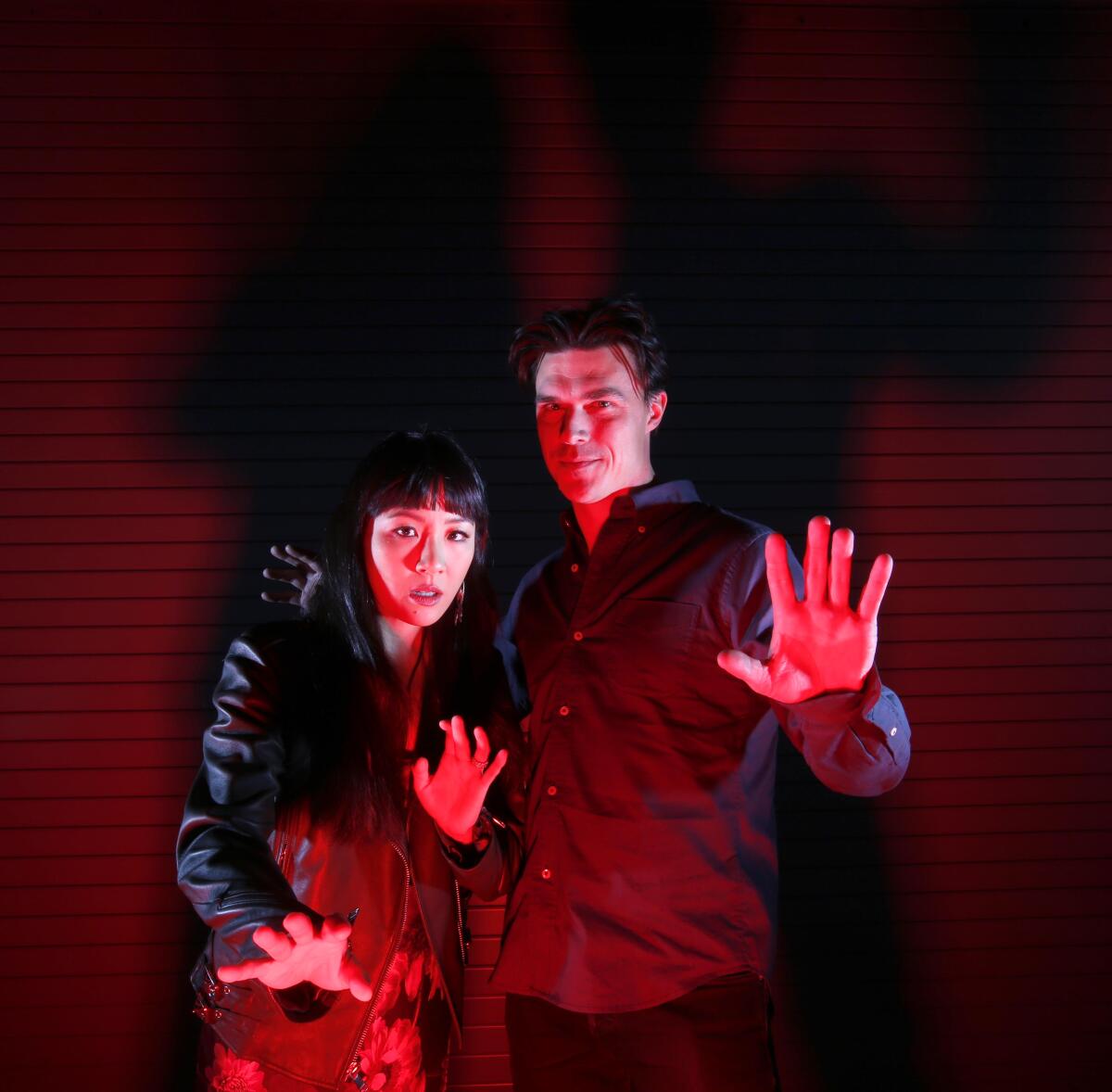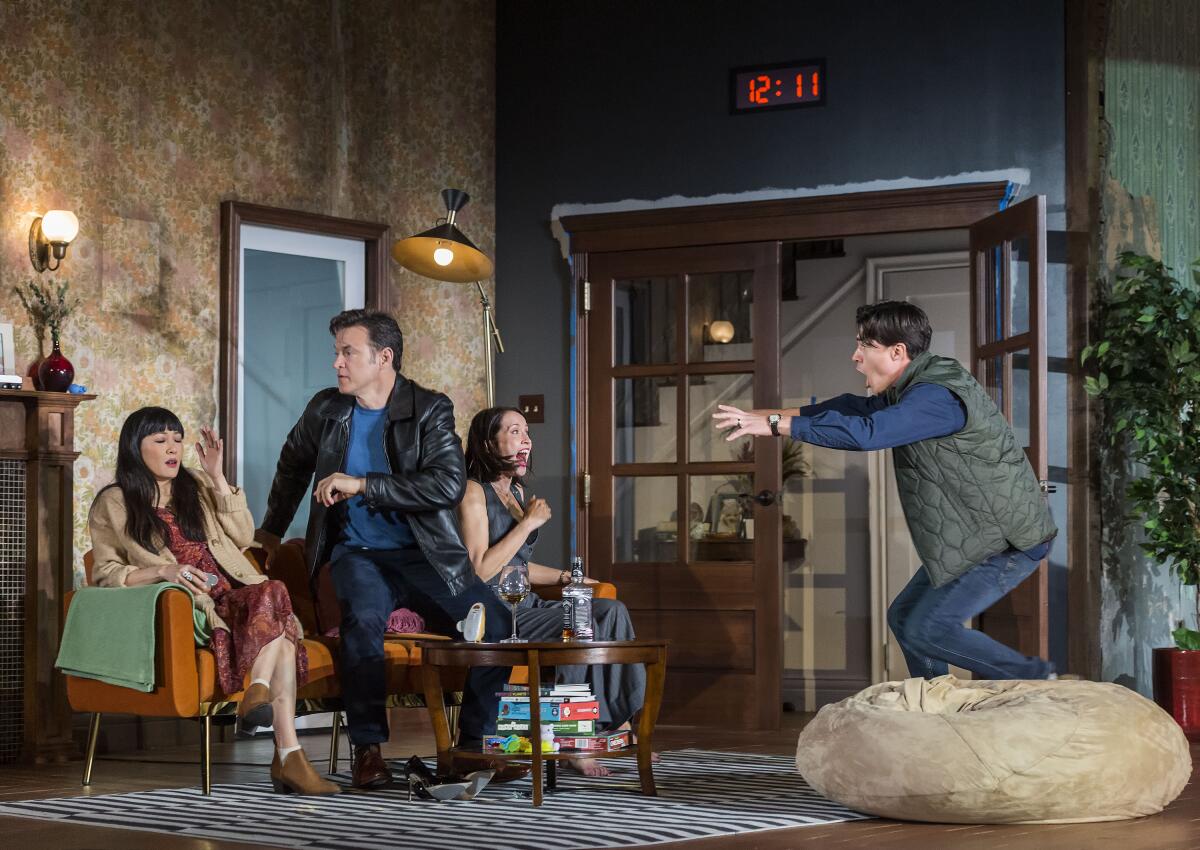Constance Wu and Finn Wittrock bring horror, and audiences, to live L.A. theater with ‘2:22’

- Share via
Horror has been key in helping the film box office recover from a pandemic-induced torpor. The genre, it turns out, might be just as good for live theater.
“2:22 — A Ghost Story,” which opened at the Ahmanson Theatre this month and runs through Dec. 4, is on pace to be Center Theatre Group’s second-bestselling production since the company reopened after the pandemic almost a year ago. (The Broadway musical “Hadestown” is first.) Opening night for “2:22” was the first to sell out since then, and the company says it’s seeing some of its biggest houses yet since before the pandemic.
Why? Star Constance Wu, who plays the young mom Jenny, has a theory. “This is f— fun. It’s thrilling. It’s entertaining,” she says, sitting with co-star Finn Wittrock for an interview in the Ahmanson’s green room.
A different kind of audience is eating up the thrills and chills. A CTG rep notes that the show is skewing younger than a traditional Ahmanson show, “with the 25-34 demo being the highest amongst our single-ticket buyers.”
The play, written by Danny Robins, staged its premiere in London’s West End in August 2021 — the first production to open since that city’s pandemic closures. Although Robins had been working on the script for years before COVID, the play’s emergence at that moment was serendipitous. It naturally attracted a more youthful, less traditional theatergoing audience — the exact audience most likely to venture into crowds during an uncertain summer.
“I think people also identified with the idea of a house feeling like a strange, alien and slightly frightening environment after having spent way too long in their own houses,” Robins says over Zoom from his London home. “And I think a ghost play felt totally perfect for that moment.”
Nonetheless, horror does not often find a home on the live stage. The genre as we have come to know it onscreen thrives on carefully edited jump scares, mountains of special effects, CGI monsters, relentless gore and movie magic makeup. Crafting horror is more complicated onstage, because the tactics used to secure that fear need to be comparatively simple.
Terror in a live environment must build through the actors, not the edit, notes Wittrock, who has been a menacing regular in various Ryan Murphy chillers, including his turn as the craven serial killer Dandy Mott in “American Horror Story: Freak Show.”
Filming horror, by comparison, Wittrock says, can be tedious and slow.
“If you’re working with blood or any kind of violence, those days just take forever, there’s so much to set up,” he says. “And it’s not scary. It’s funny. We laugh halfway through it.”
Tension is added much later in the cutting room, Wittrock says, whereas onstage, “the tension is between the characters every night.” With live theater the delivery of lines has to be fast and clipped to keep the momentum. Director Matthew Dunster’s biggest notes during rehearsal, the actors say, were, “speed, pace, energy, cues.”
To give audiences the creeps, “2:22” uses sound (including ear-shattering shrieks and a driving rock soundtrack), lighting and an ominous digital clock that counts down to the titular minute of denouement.
Then there is the baby monitor, a device that — by channeling all of the anxiety of new parenthood — becomes a portal for hearing an otherworldly presence.
The outsize menace coming through that seemingly benign piece of technology pairs perfectly with one of the show’s most resonant lines, played for nervous laughs by Wittrock: “I challenge anyone to be a parent and not be permanently terrified.”
“Having a kid is a hack into your emotions,” Wittrock says. “I think about my kids and I’m raw. And so to imagine your child in danger, you don’t even have to work at the feeling that creates in you primally.”

Wittrock plays a new father named Sam whose wife (Wu) begins hearing ghostly footsteps and crying in her daughter’s room at 2:22 a.m. each night. Sam, a skeptic and a scientist, doesn’t believe her. When another couple, Lauren (Anna Camp) and Ben (Adam Rothenberg), come for dinner, Jenny prevails on them to stay until the witching hour to prove she is not making things up.
What follows is a locked-door mystery nestled into a drunken dinner party, with the argumentative leads marking time until the truth is revealed.
The baby in “2:22” is named Phoebe. She sleeps on an unseen second floor, in a room just above the mainstage action — her every gurgle, whine and cry jolting Jenny like an electric current. In this way, baby and monitor fuse together to become the fifth character in the play.
Paranoia, when you’re a parent, is everywhere, adds Wu, recalling how she Googled about sleep training when she had her baby — and got a hit about sudden infant death syndrome.
“It pops up in your feed even if you don’t look for it,” says Wu, shaking her head.
Children hold a significant place in horror, notes Robins.
“There’s something very unsettling about a vulnerable child or a disturbed child,” he says.
And, indeed, the genre is awash with instances of kids bringing the real horror to a head, including Danny in “The Shining,” little demonic Damien in “The Omen” and practically any kid unlucky enough to be featured in the “Child’s Play” franchise.
In “2:22” audience members don’t so much fear for Phoebe as they do for her parents, who are clearly unraveling under the weight of their new-parent anxiety. Is there a ghost, the play asks, or is this sleep-deprived mother slowly going insane? (Knowing parents in the audience might suspect the latter.)
The play is littered with Easter eggs hinting at the reality of the situation, but whatever the answer might be, questions about the nature and meaning of death abound. These days, Robins says, people are seeking otherworldly escape from the chaos and uncertainty of this uniquely terrifying moment.
“We are confronted by our mortality in a way that we haven’t been, probably since the Second World War,” says Robins, citing COVID, climate change and the war in Ukraine. “All of these things make us think about death. And I think that, at the heart of it, our interest in the supernatural is about death.”
What happens after we’re gone? A ghost may be scary, says Robins, but at least it’s still here.
That, and what Wu says: Audiences just wanna have fun.
'2:22 — A Ghost Story'
Where: Ahmanson Theatre, 135 N. Grand Ave., L.A.
When: 8 p.m. Tuesdays-Fridays, 2 and 8 p.m. Saturdays, 1 and 6:30 p.m. Sundays (call for exceptions); ends Dec. 4
Tickets: $40-$175 (subject to change)
Information: (213) 972-4400 or centertheatregroup.org
Running time: 2 hours, including one intermission
COVID protocol: Masks are strongly recommended
More to Read
The biggest entertainment stories
Get our big stories about Hollywood, film, television, music, arts, culture and more right in your inbox as soon as they publish.
You may occasionally receive promotional content from the Los Angeles Times.











